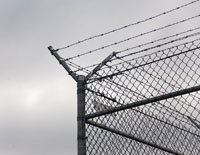News & Commentary
Chains Hurt Children: The Harm of Restraints
This is the fifth in a series of posts on the topic of juvenile shackling. The automatic shackling or use of restraints on youth in juvenile court does not promote safety. Instead, it actually promotes humiliation, hurts children’s mental and emotional stability, and fails to teach youth the concept of respect. Most children in the juvenile court system are accused of low-level, sometimes non-criminal offenses and pose no risk. Yet, they are forced to wear chains and other degrading restraints that leave long lasting emotional scars.

American Bar Association Opposes Automatic Shackling of Juveniles in Court
This is the fourth in a series of posts on the topic of juvenile shackling. More often than not, progress happens in steps. That was certainly true of the American Bar Association’s (ABA) evolving policy on juvenile justice. In 2014, the ABA passed a resolution urging the “development of trauma-informed, evidence-based approaches and practices on behalf of justice system involved children and youth who have been exposed to violence, including child abuse and neglect or other crimes and those subject to delinquency or status offence proceedings.” The resolution also noted that, “Some routine juvenile justice practices, such as solitary confinement, isolation, and restraint, can further traumatize youth and cause them additional harm.”

Extreme Sentence is Essentially Life Without Parole
Should you spend life in prison for something you did as a teenager?

Shackling: Ohio Juvenile Courts Should Have Rules on Restraints
This is the third in a series of posts on the topic of juvenile shackling. This is Nate P. and I’m writing you this letter to let you know that cuffs and shackles make me feel like a criminal, not a “juvenile delinquent.” Shackles hurt and embarrass me most of the time. My opinion is that they are not necessary. When I wear cuffs and shackles I am judged immediately. I am writing this letter to you so that we can come up with a solution. What if one of your sons or daughters was shackled for a minor, non-violent crime? Think about it, we are kids.

Worse Than Adults: The Shackling of Youth in Juvenile Court
Tim Williamson,’ Detained youth,
Forty-seven years ago, the U.S. Supreme Court’s landmark ruling In re Gault held that young people are entitled to the same procedural rights as adults in court proceedings. However, one right that adults have in Ohio, that young people do not have, is the right to appear in court free of restraints.
Courts have ruled that restraints may only be used on adults who pose a safety risk or who have a documented history of escape. Adults in Ohio and around the country have the right to appear in court without handcuffs, belly chains, or leg irons regardless of the charges they face. Only an adult who has been documented to be a serious safety risk may be shackled, and the court must use due process and evidence to determine this. The use of restraints in adult courts is rare.
Youth in several states in the nation have the right to appear in court unrestrained. However, in Ohio’s juvenile courts, the use of restraints is common.
Due to this inconsistency between Ohio’s adult court and juvenile court, an adult facing multiple serious charges will not wear restraints while a youth facing minor or non-criminal charges will.
This does not seem right, does it?
Research and the U.S. Supreme Court have found that minors are less culpable and more amenable to rehabilitation than adults.
So why are we treating them more harshly than adults?
We must treat our youth as well—or better—than we do adults in the justice system. It’s time to unshackle Ohio’s youth.

Treating Our Addiction to Mass Criminalization
“The United States will never be able to prosecute or incarcerate its way to being a safer nation,” said last week U.S. Attorney General Eric Holder, at a conference held by the Brennan Center for Justice at the New York University School of Law.

Stay Informed
Sign up to be the first to hear about how to take action.
By completing this form, I agree to receive occasional emails per the terms of the ACLU’s privacy statement.
By completing this form, I agree to receive occasional emails per the terms of the ACLU’s privacy statement.



